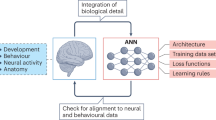Abstract
Computational neuroscience is a subfield of neuroscience that develops models to integrate complex experimental data in order to understand brain function. To constrain and test computational models, researchers need access to a wide variety of experimental data. Much of those data are not readily accessible because neuroscientists fall into separate communities that study the brain at different levels and have not been motivated to provide data to researchers outside their community. To foster sharing of neuroscience data, a workshop was held in 2007, bringing together experimental and theoretical neuroscientists, computer scientists, legal experts and governmental observers. Computational neuroscience was recommended as an ideal field for focusing data sharing, and specific methods, strategies and policies were suggested for achieving it. A new funding area in the NSF/NIH Collaborative Research in Computational Neuroscience (CRCNS) program has been established to support data sharing, guided in part by the workshop recommendations. The new funding area is dedicated to the dissemination of high quality data sets with maximum scientific value for computational neuroscience. The first round of the CRCNS data sharing program supports the preparation of data sets which will be publicly available in 2008. These include electrophysiology and behavioral (eye movement) data described towards the end of this article.

Similar content being viewed by others
References
Ascoli, G. A. (2006). The ups and downs of neuroscience shares. Neuroinformatics, 4, 213–215.
Bjaalie, J. G., & Grillner, S. (2007). Global neuroinformatics: The international neuroinformatics coordination facility. Journal of Neuroscience, 27, 3613–3615.
Gardner, D. (2004). Neurodatabase.org: networking the microelectrode. Nature Neuroscience, 5, 486–487.
Gardner, D., Toga, A. W., Ascoli, G. A., Beatty, J. T., Brinkley, J. F., Dale, A. M., et al. (2003). Towards effective and rewarding data sharing. Neuroinformatics, 1, 289–294.
Harris, K. D., Csicsvari, J., Hirase, H., Dragoi, G., & Buzsaki, G. (2003). Organization of cell assemblies in the hippocampus. Nature, 424, 552–556.
Harris, K. D., Henze, D. A., Csicsvari, J., Hirase, H., & Buzsaki, G. (2000). Accuracy of tetrode spike separation as determined by simultaneous intracellular and extracellular measurements. Journal of Neurophysiology, 84, 401–414.
Harris, K. D., Henze, D. A., Hirase, A., Leinekugel, X., Dragoi, G., Czurko, A., et al. (2002). Spike train dynamics predicts theta-related phase precession in hippocampal pyramidal cells. Nature, 417, 738–741.
Insel, T. R., Volkow, N. D., Landis, S. C., Li, T. K., Battley, J. F., & Sieving, P. (2004). Limits to growth: Why neuroscience needs large-scale science. Nature Neuroscience, 7, 426–427.
Kennedy, D. N. (2006). Where’s the beef? Missing data in the information age. Neuroinformatics, 4, 271–273.
Koetter, R. (2004). Online retrieval, processing and visualization of primate connectivity data from the CoCoMac database. Neuroinformatics, 2, 127–136.
Liu, Y., & Ascoli, G. A. (2007). Value added by data sharing: Long-term potentiation of neuroscience research. Neuroinformatics, 5, 143–145.
Van Horn, J. D., & Ishai, A. (2007). Mapping the human brain: New insights from fMRI data sharing. Neuroinformatics, 5, 146–153.
Acknowledgements
The authors thank the other participants of the workshop: Giorgio Ascoli (George Mason University); György Buzsáki (Rutgers University); Mike Hasselmo (Boston University); Judith Hirsch and Laurent Itti (both from University of Southern California); John Hogenesch (University of Pennsylvania); Terran Lane (University of New Mexico); Dario Ringach (University of California, Los Angeles); Raphael Ritz (International Neuroinformatics Coordination Facility, Stockholm); and Tim Blanche, Yang Dan, Jack Gallant (all from University of California, Berkeley). Thinh Nguyen (Science Commons, Cambridge, MA) provided legal expertise. Government observers (from various agencies) were: Christopher Greer, Dennis Glanzman,Yuan Liu, Peter Lyster, Michael Marron, Rae Silver and Ken Whang. Most of the ideas in this article have emerged from discussions at the workshop. Tim Blanche and Martin Rehn provided helpful feedback on drafts of this article. The authors thank numerous other researchers who provided thoughtful responses to an initial request for comments on data sharing issued by NSF in March 2007. The work described in this article was supported by NSF Grant 0636838 to K. D. Harris, Rutgers University, and by NSF Grant 0749049 to F. T. Sommer, UC Berkeley.
Author information
Authors and Affiliations
Corresponding author
Rights and permissions
About this article
Cite this article
Teeters, J.L., Harris, K.D., Millman, K.J. et al. Data Sharing for Computational Neuroscience. Neuroinform 6, 47–55 (2008). https://doi.org/10.1007/s12021-008-9009-y
Received:
Accepted:
Published:
Issue Date:
DOI: https://doi.org/10.1007/s12021-008-9009-y




